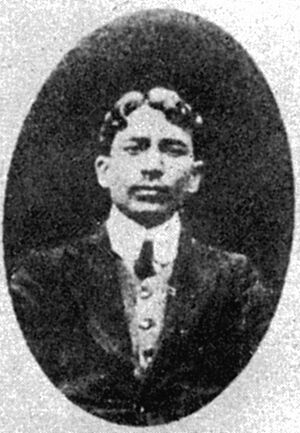Madan Lal Dhingra facts for kids
Quick facts for kids
Madan Lal Dhingra
|
|
|---|---|
 |
|
| Born | 18 February 1883 Amritsar, Punjab, British India
|
| Died | 17 August 1909 (aged 26) |
| Cause of death | Execution by hanging |
| Organization | India House |
| Movement | Indian independence movement |
| Criminal penalty | Death |
| Criminal status | Executed |
Madan Lal Dhingra (born February 18, 1883 – died August 17, 1909) was an important figure in India's fight for freedom. He was a revolutionary and worked hard for India to become independent from British rule. While studying in England, he took action against a British official, William Hutt Curzon Wyllie. Dhingra saw this as a patriotic act and a way to get revenge for the unfair treatment of Indians by the British government in India.
Contents
Madan Lal Dhingra's Early Life
Madan Lal Dhingra was born in Amritsar, India, on February 18, 1883. His family was well-educated and wealthy. His father, Dr. Ditta Mal Dhingra, was a civil surgeon. Madan Lal was one of eight children, and all seven sons, including him, studied abroad.
Dhingra studied in Amritsar until 1900. Then he went to Government College University in Lahore. There, he learned about the growing movement for Indian self-rule. He was very concerned about the widespread poverty in India. He read many books about why India was poor and had famines. He believed that the solutions were in Swaraj (self-government) and the Swadeshi movement (using Indian-made goods).
Dhingra strongly supported the Swadeshi movement. This movement wanted India to become more self-sufficient. It encouraged Indian businesses and urged people to avoid buying British goods. He felt that British policies were designed to harm Indian industries. This, he believed, was a main reason for India's lack of economic growth.
In 1904, while studying for his Master of Arts, Dhingra led a student protest. The college principal had ordered that blazers be made from cloth imported from Britain. Dhingra was expelled for this. His father, who worked for the government, wanted him to apologize. But Dhingra refused. He chose to live on his own terms.
After being expelled, Dhingra worked as a clerk in Kalka. He later worked as a factory laborer. He even tried to start a workers' union but was fired for it. He then moved to Bombay and worked low-level jobs. His family worried about him. His older brother, Dr. Bihari Lal, convinced him to go to Britain for higher education. Dhingra agreed. In 1906, he went to University College, London, to study mechanical engineering.
Joining the Independence Movement
Dhingra arrived in London in 1906. This was a year after Shyamji Krishna Varma started India House in 1905. India House was a meeting place for Indian activists in Highgate.
Dhingra met important Indian independence activists there. These included Vinayak Damodar Savarkar and Shyamji Krishna Varma. They were impressed by his strong desire for India's freedom. Savarkar believed in revolution. He inspired Dhingra's deep commitment to the independence movement.
Later, Dhingra spent less time at India House. He often visited a shooting range. He also joined a secret group called the Abhinav Bharat Mandal. Savarkar and his brother, Ganesh, founded this group.
During this time, Savarkar, Dhingra, and other students were very upset. They were angry about the 1905 Partition of Bengal. Dhingra's father, Ditta Mall, who was a Chief Medical Officer, stopped supporting him because of his political activities. His father even announced this in newspapers.
The Action Against Curzon Wyllie
Weeks before the event, Dhingra had tried to take action against Lord Curzon. Lord Curzon was a former Viceroy of India. Dhingra also planned to act against Bampfylde Fuller, a former Lieutenant-Governor. But he was late for a meeting and could not carry out his plan. Dhingra then decided to focus on Curzon Wyllie.
Curzon Wyllie had joined the British Army in 1866. He worked in the Indian Political Department from 1879. He had served in various places in India. In 1901, he became a political aide to the Secretary of State for India. He was also in charge of the Secret Police. He had been trying to gather information about Dhingra and other activists. Curzon Wyllie was said to be a close friend of Dhingra's father.
On the evening of July 1, 1909, Dhingra went to an event. Many Indians and Englishmen were there. It was the annual 'At Home' function hosted by the Indian National Association. When Curzon Wyllie was leaving the hall, Dhingra took action. He saw this as a patriotic act. He also saw it as revenge for the unfair killings of Indians by the British government.
Dhingra was arrested right away by the police. He was found guilty and sentenced to execution.
Remembering Madan Lal Dhingra
After his execution, British authorities did not allow Dhingra's body to have Hindu rites. They buried him. His family had disowned him, so the authorities refused to give his body to Savarkar. Dhingra's coffin was later found by accident. This happened while authorities were looking for the remains of Shaheed Udham Singh. His remains were sent back to India on December 13, 1976. They are now kept in a main square in Akola, Maharashtra, which is named after him.
Madan Lal Dhingra is widely remembered in India today. He inspired other revolutionaries like Bhagat Singh and Chandrasekhar Azad.
Some groups wanted his ancestral home to become a museum. However, his family members do not wish to recognize his legacy. They refused to take part in events honoring his death in August 2015. The family sold his ancestral house. They also turned down an offer to buy it from a political leader named Laxmi Kanta Chawla. She had wanted to turn it into a museum.
See also
- India House
- List of Indian independence activists


